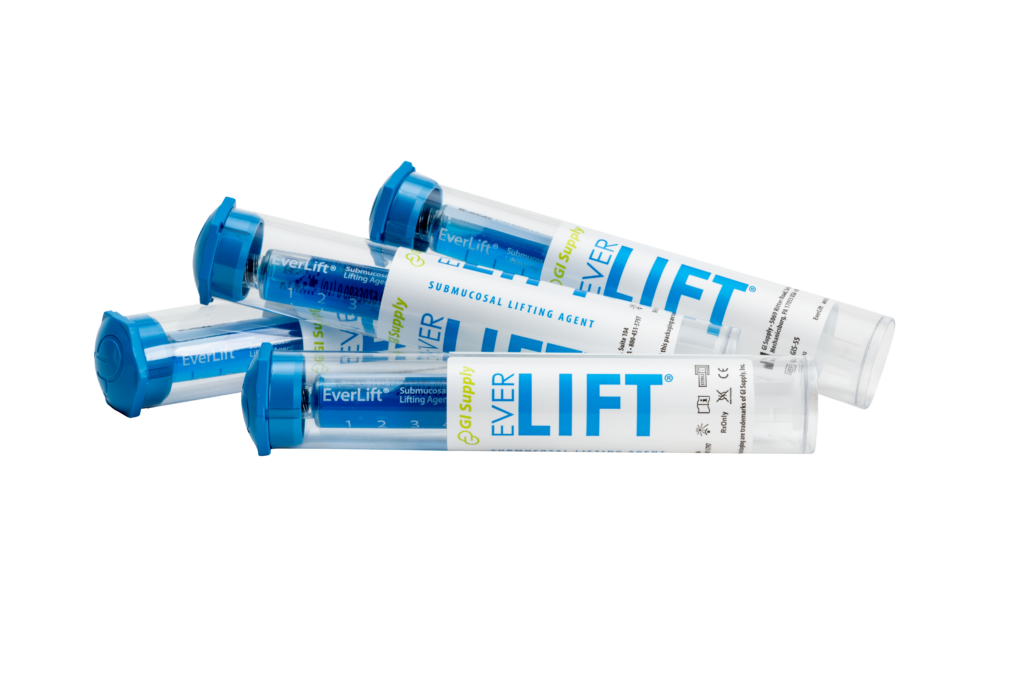



Review conducted by Gary “Taavi” Reiss, MD and Robert M. Najarian, MD
August 2022 | Mechanicsburg, PA
In a 2021 post-market clinical follow-up study conducted by Gary “Taavi” Reiss, MD, Director of Interventional Gastroenterology at Metropolitan Gastroenterology Associates and reviewed by Robert M. Najarian, MD Gastrointestinal Pathologist and Medical Director at University Gastroenterology’s Pathology Center, showed that unlike other submucosal lifting agents, EverLift Submucosal Lifting Agent does not produce artifacts post endoscopic mucosal resection or endoscopic submucosal dissection.
A whitepaper was developed with the purpose of confirming that EverLift is a safe and superior lifting option to consider. The study confirms that the 5 mL pre-filled syringes offer waste-reduction and cost-saving opportunities. In addition, it drives awareness of the potential for pathologists to misinterpret residue that some submucosal lifting agents have been found to leave behind causing additional testing to be conducted.
“It is critically important for the gastroenterologist to collaborate with the pathologist by mentioning whether a lifting agent was used during lesion removal, and if so, which specific agent was used. If the pathologist is unaware of the artifacts that can be induced by certain lifting agents, additional costly stains may be required to arrive at a correct diagnosis. Thus, the collaboration between endoscopist and pathologist enables better diagnoses and overall patient care.”
Robert M. Najarian, MD, Gastrointestinal Pathologist and Medical Director at University Gastroenterology’s Pathology Center
In the study, data was analyzed from 71 patients and there were no indications of artifacts or intraprocedural patient reactions caused or contributed by the device; no reports of intraprocedural complications at or adjacent to the injection site, and no report of post-procedure (24-hour) related complications.3
Key Points
“One of the things EverLift is best at is its deep blue color. It has very good coloration, allowing easy visualization of lesions margins. But the main advantage to us is that it comes in 5 mL aliquot, which is less expensive and easy for us to use. Also, we have not observed any questionable granulomas or anything else that would point to artifacts.”
Gary “Taavi” Reiss, MD, Director of Therapeutic Endoscopy at Metropolitan Gastroenterology Associates.
Please click HERE to access the full white paper.
ABOUT EVERLIFT SUBMUCOSAL LIFTING AGENT
EverLift Submucosal Lifting Agent is an injectable liquid offered in a 5 mL or 10 mL prefilled syringe for use during endoscopic mucosal resection (EMR), endoscopic submucosal dissection (ESD), and polypectomy procedures in the gastrointestinal tract. EverLift is pre-mixed with methylene blue4 to highlight the lesion perimeter and aid in increased occurrence of en bloc resection rates, reduced occurrence of residual lesion and incomplete resections, and improved identification of muscle injury to help avoid missed perforations.
INTENDED USE
EverLift Submucosal Lifting Agent is indicated for use in gastrointestinal endoscopic procedures for submucosal lift of polyps, adenomas, early-stage cancers, or other gastrointestinal lesions prior to excision with a snare or other appropriate endoscopic device.
References
106467–1